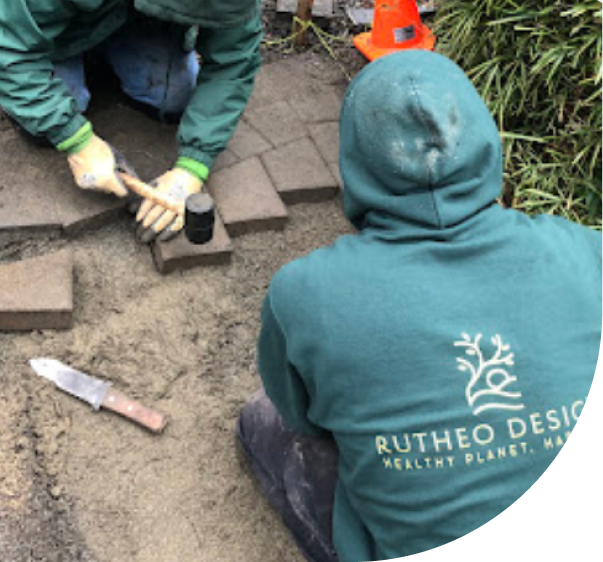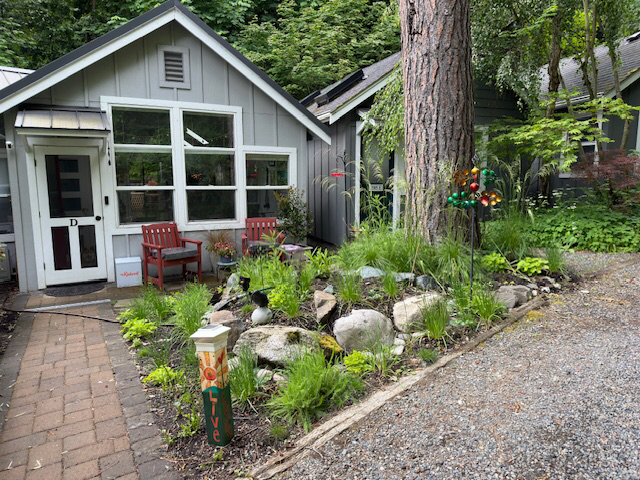
At Rutheo Designs, we create sustainable, interactive water features that provide children with a fun and safe way to connect with nature while promoting water conservation. Our designs prioritize eco-friendly materials, recirculating water systems, and non-slip surfaces to ensure durability, safety, and minimal environmental impact. From splash pads with motion-activated misting systems to bubbling rock fountains and naturalistic water streams, we tailor every project to fit seamlessly into the surrounding landscape. By incorporating rainwater harvesting and energy-efficient pumps, we reduce water waste while maintaining a constant flow, allowing kids to engage in hands-on learning about sustainability through play.
Each water feature is thoughtfully designed to balance adventure and accessibility, ensuring children of all ages and abilities can enjoy outdoor water play. Adaptive elements such as elevated water tables, sensory-friendly fountains, and gently sloped splash areas create inclusive spaces that encourage creativity and movement. We integrate native plant buffers, permeable surfaces, and pollinator-friendly landscaping to enhance the ecological benefits of these play areas. Whether in a residential backyard or a community park, our water features transform outdoor spaces into dynamic, low-maintenance environments that inspire exploration while respecting Seattle’s natural resources.
Ensuring water play areas are safe for children is a fundamental aspect of sustainable landscaping design. Non-slip surfaces, such as textured concrete or rubberized flooring, help prevent slips and falls, while shallow water designs eliminate drowning risks and provide age-appropriate play spaces. Soft-edged materials, like smooth stone or eco-friendly rubber padding, offer impact absorption to minimize injury risks in active play zones.
Water circulation systems play a crucial role in keeping water features clean and safe. Stagnant water can harbor bacteria and mosquitoes, making recirculating pumps and biofiltration essential components of any well-designed water feature. UV filtration and natural plant-based filtration systems further enhance water quality, reducing the need for chemical treatments and ensuring a safe, eco-friendly play experience.
Designing water play areas for different age groups enhances engagement and safety. Gentle splash pads with soft jets and minimal standing water provide a safe and sensory-friendly experience for toddlers and young children. Interactive water tables encourage hands-on exploration, allowing children to experiment with water movement, floatation, and flow dynamics.
For older children, shallow wading streams replicate the experience of natural creeks, inviting imaginative play while promoting connection with nature. Multi-level water elements, such as cascading water chutes and mini waterfalls, create dynamic play spaces that encourage movement, creativity, and social interaction.
A truly engaging water play area must be inclusive for children of all abilities. Wheelchair-accessible splash zones with gradual slopes and wide pathways ensure that all children can participate in water play. Adaptive features such as sensory water walls, musical fountains, and misting stations cater to children with sensory processing needs, providing diverse play opportunities.
Elevated water tables make water play accessible to seated children, allowing them to engage with water flow, texture, and movement without barriers. Thoughtful design elements ensure that water features provide meaningful, interactive experiences for every child, regardless of mobility or sensory preferences.
Splash pads provide a low-water-use alternative to traditional pools, using motion-activated jets to conserve water while creating engaging play spaces. Integrated misting stations offer a cooling effect during warm summer months while reducing excessive water consumption. Permeable surfaces help absorb excess water, preventing runoff and making the play area safer and more sustainable.
Incorporating interactive elements into water play spaces fosters creative and cooperative play. Hand pumps and water chutes allow children to manipulate water flow, while spinning fountains and water wheels encourage cause-and-effect learning. Combining sand and water play areas introduces textural variety, inspiring sensory exploration and imaginative construction activities.
Water streams provide a naturalistic play experience, mimicking real-life creeks where children can observe water movement and interact with floating objects. Bubbling rock fountains offer a calming, continuous flow of water, introducing soothing sounds and visual stimulation to the space. Low-flow waterfalls add an additional layer of play while maintaining water efficiency.
Pondless waterfalls provide a safe, low-maintenance alternative to traditional ponds, eliminating standing water risks while maintaining the beauty and movement of cascading water. Rain gardens serve as functional and educational elements, teaching children about stormwater management while filtering runoff through native plants. By integrating water features with pollinator-friendly plants, we create habitats that attract beneficial insects and birds, enriching the natural ecosystem.
Water conservation is a key consideration in sustainable play area design. Rainwater harvesting systems capture and store runoff for use in water features, reducing reliance on municipal water supplies. Drip irrigation techniques complement water play elements, ensuring that landscape plantings remain hydrated while minimizing evaporation and waste. Permeable surfaces allow water to be absorbed into the ground naturally, replenishing groundwater and preventing excessive runoff.
Using recirculating water systems significantly reduces waste by continuously filtering and reusing water. Energy-efficient pumps regulate water movement while minimizing energy consumption. UV filtration systems and biofiltration techniques keep water clean without harsh chemicals, creating a healthier play environment for children. Smart sensors can be integrated into water play areas to regulate usage, turning water features on and off as needed to prevent excess water loss.
Drought-resistant landscaping principles help ensure that water play features remain sustainable even in dry conditions. Applying xeriscaping techniques, such as incorporating native plants and mulch around water features, reduces overall water demand. Seasonal adaptability allows water play areas to be functional during wetter months while transitioning into dry play zones during drought periods. By using native plant buffers, we support local ecology while reducing unnecessary irrigation and water use.
Water features are most effective when seamlessly integrated into broader play landscapes, creating an immersive experience that engages children in nature-based exploration. Combining water play areas with sensory gardens enhances the overall experience, offering spaces where children can engage with water while also exploring textures, scents, and colors of plants selected for their interactive qualities.
Incorporating natural rock and wood features into water play zones enhances aesthetic appeal and ensures the design remains harmonious with the surrounding environment. Boulder formations, driftwood structures, and log stepping paths allow for safe movement while maintaining an organic, nature-inspired aesthetic. To ensure year-round usability, water play spaces should transition smoothly into dry play areas. This approach allows children to enjoy different aspects of the landscape throughout the seasons, adapting play opportunities based on weather conditions.
A sustainable water play area should not only provide entertainment but also support the local ecosystem. Butterfly and bee-friendly plantings near water features encourage pollination, bringing a diversity of beneficial insects that contribute to the health of the landscape. Selecting native plants that thrive in riparian settings helps create a habitat that sustains biodiversity while requiring minimal maintenance.
Non-toxic water treatments ensure that children, pets, and wildlife can safely interact with water features. Chemical-free filtration systems, such as UV treatment or plant-based biofiltration, help maintain clean water without introducing harmful substances into the environment. Designing natural pond edges allows amphibians and birds to safely access water sources, promoting biodiversity and supporting native species. This integration of wildlife-friendly elements transforms a simple play area into a thriving ecological space.
A well-designed water feature should cater to the entire family, offering both play and relaxation spaces. Seating and shaded areas allow parents to supervise their children comfortably while also providing quiet spots for relaxation. Natural shade from trees or strategically placed pergolas can enhance comfort while complementing the overall design aesthetic.
Water features can transition from active play spaces to calming retreat areas. Bubbling rock fountains, shallow streams, and misting stations can serve as both play elements and cooling features on hot days. Additionally, designing multi-age water play areas ensures long-term usability, allowing children of different developmental stages to engage with the space in meaningful ways.

At Rutheo Designs, we are dedicated to transforming your outdoor spaces into beautiful, sustainable landscapes that reflect your vision and the unique character of the Seattle area. Whether you’re looking to enhance your garden with native plants, need expert advice on water-efficient irrigation systems, want to explore custom hardscaping for your outdoor living space, or discuss a comprehensive landscape design, our team is here to assist you every step of the way. We offer services in native plant landscaping, water-efficient irrigation, custom landscape design, and hardscaping solutions tailored to your goals and the local environment. Every project is unique, and we take the time to listen to your needs and offer personalized solutions that align with both your aspirations and Seattle’s natural surroundings.
We invite you to reach out to us to start the conversation about your landscaping needs. You can contact us by email at connect@rutheodesigns.com or give us a call at (360) 844-2989. Whether you have specific questions or are ready to schedule a consultation, we’re eager to help you bring your outdoor vision to life with the care and expertise that Rutheo Designs is known for.